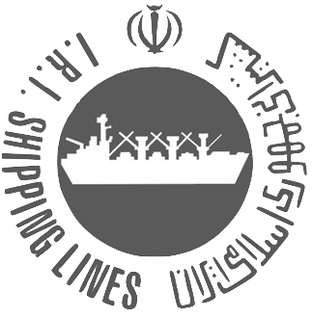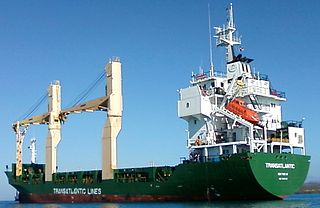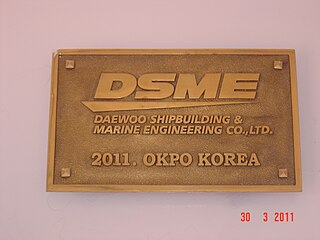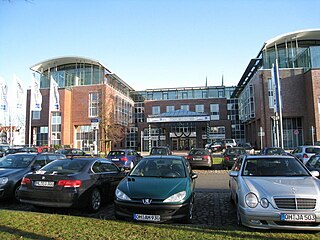
A bulk carrier or bulker is a merchant ship specially designed to transport unpackaged bulk cargo—such as grain, coal, ore, steel coils, and cement—in its cargo holds. Since the first specialized bulk carrier was built in 1852, economic forces have led to increased size and sophistication of these ships. Today's bulk carriers are specially designed to maximize capacity, safety, efficiency, and durability.
Odense Steel Shipyard was a Danish shipyard company located in Odense. It was best known for building container ships for its parent group, A.P. Moller – Maersk Group, including the Mærsk E class in 2006 which at the time were the biggest container ships in the world. The global financial crisis led to Maersk announcing its closure in 2009 and the last new ship was delivered in January 2012.

Cochin Shipyard Ltd (CSL) is the largest shipbuilding and maintenance facility in India. It is part of a line of maritime-related facilities in the port-city of Kochi, in the state of Kerala, India. Of the services provided by the shipyard are building platform supply vessels and double-hulled oil tankers. It built the first indigenous aircraft carrier for the Indian Navy, the INS Vikrant. The company has Miniratna status.

The Islamic Republic of Iran Shipping Line Group, commonly known by its business name IRISL Group, is a shipping line based in and owned by Iran. Its fleet comprises 115 ocean-going vessels with a total capacity of 3.3 million tons deadweight (DWT), with 87 being ocean-going vessels owned by IRISL and the remaining 28 ships being owned under the flags of subsidiary companies, including Khazar Shipping, Valfajr and Iran-India Shipping. They are manned by 6,000 personnel who work under the Iranian flag in the Caspian Sea, Persian Gulf, international waters and various ports of the world.

An oil tanker, also known as a petroleum tanker, is a ship designed for the bulk transport of oil or its products. There are two basic types of oil tankers: crude tankers and product tankers. Crude tankers move large quantities of unrefined crude oil from its point of extraction to refineries. Product tankers, generally much smaller, are designed to move refined products from refineries to points near consuming markets.

MV Maria Reina is a Panamanian container ship. The 100-metre (330 ft) long ship was built at Wuhu Shipyard in Wuhu, China in 1997 as Steamers Future. Originally owned by Singapore's Keppel Corporation, she has had three owners, been registered under three flags, and been renamed ten times.

Fednav is a privately owned Canadian company in the maritime transport industry, involved in transporting over 30 million tonnes of bulk cargo and break bulk cargo worldwide. Its fleet comprises approximately 120 long-term and spot-chartered vessels. The fleet includes most of St. Lawrence Seaway's maximum-sized bulk carriers, Supramax, and Panamax vessels.
Atlantska plovidba d.d. is a Croatian shipping company. Founded in 1955 in Dubrovnik, the company works mostly in the dry bulk and heavy lift markets, serving both domestic and international clients.
Stephenson Clarke Shipping Limited, established in 1730 is Great Britain's oldest shipping company. The company specializes in short sea bulk cargo such as aggregates, alumina, grain, coal, fertilizers and steel.

Sanoyas Hishino Meisho Corporation is a Japanese company that consists of four principal business groups and twelve affiliated companies. The business groups are: the Ship and Steel Structure Group, the Parking System & Engineering Group, the Construction Machines Group, and the Leisure Business Group.
Portline Transportes Marítimos Internacionais, SA., often simply called Portline is a Portuguese shipping company. The company has diverse business activities, including dry bulk, containerised, and break-bulk cargo shipping, shipping agency, forwarding and logistics services, ship management and manning, ship brokerage and chartering, and a container depot service.

MS Ore Brasil, previously known as Vale Brasil, is a very large ore carrier owned by the Brazilian mining company Vale. She is the first of seven 400,000-ton very large ore carriers (VLOC) ordered by Vale from Daewoo Shipbuilding & Marine Engineering in South Korea and twelve from Jiangsu Rongsheng Heavy Industries in China, which are designed to carry iron ore from Brazil to Asia along the Cape route around South Africa. While close to the specifications of Chinamax, these ships are generally referred to as Valemax vessels by Vale. They are the largest bulk carriers ever built.

Valemax ships are a fleet of very large ore carriers (VLOC) owned or chartered by the Brazilian mining company Vale S.A. to carry iron ore from Brazil to European and Asian ports. With a capacity ranging from 380,000 to 400,000 tons deadweight, the vessels meet the Chinamax standard of ship measurements for limits on draft and beam. Valemax ships are the largest bulk carriers ever constructed, when measuring deadweight tonnage or length overall, and are amongst the longest ships of any type currently in service.
Federal Tiber is a bulk carrier. It was the first freighter to ship iron ore from the Baffinland mines, out of Milne Inlet, on its way to Nordenham, Germany, on August 8, 2015. CBC North reported it carried 53,624 tonnes of ore.

Rio de la Plata is a container ship owned by A.P. Moller Singapore Pte. Ltd. and operated by Maersk Line AS. The 286.45-metre (939.8 ft) long ship was built at Daewoo Shipbuilding & Marine Engineering in Okpo, South Korea in 2008. Originally owned by Rio de Janeiro GmbH & Co KG, a subsidiary of Hamburg Süd, she has had two owners and been registered under two flags.

Rio de Janeiro is a container ship owned by A.P. Moller Singapore Pte. Ltd. and operated by Maersk Line AS. The 286.45-metre (939.8 ft) long ship was built at Daewoo Shipbuilding & Marine Engineering in Okpo, South Korea in 2008. Originally owned by Rio de Janeiro GmbH & Co KG, a subsidiary of Hamburg Süd, she has had two owners and been registered under two flags.

Monte Tamaro is a container ship owned by A.P. Moller Singapore Pte. Ltd. and operated by Maersk Line AS. The 272-metre (892 ft) long ship was built at Daewoo Shipbuilding & Marine Engineering in Okpo, South Korea in 2007. Originally owned by Monte Tamaro GmbH & Co KG, a subsidiary of Hamburg Süd, she has had two owners and been registered under three flags.

Monte Azul is a container ship owned by A.P. Moller Singapore Pte. Ltd. and operated by Maersk Line AS. The 272-metre (892 ft) long ship was built at Daewoo Mangalia Heavy Industries in Mangalia, Romania in 2007/2008. Originally owned by Monte Azul GmbH & Co KG, a subsidiary of Hamburg Süd, she has had two owners and been registered under three flags.

Oldendorff Carriers is a family owned shipping company with headquarters in Lübeck.

The Sasebo Heavy Industries Co., Ltd., also simply known as the Sasebo Heavy Industries, is a company whose main business is heavy industry, based in Sasebo City, Nagasaki Prefecture. A wholly owned subsidiary of Namura Shipbuilding. Known as SSK. It is an acronym for Sasebo Ship Industry, which was the company name when it was first established.















